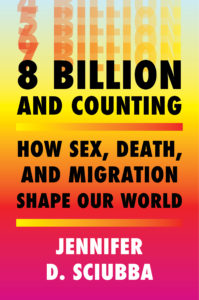Laura’s note: Ahead of Mother’s Day, I’m pleased to welcome Jennifer Sciubba to the blog. She is the author of the new book 8 Billion and Counting: How Sex, Death, and Migration Shape Our World, and an Associate Professor in the Department of International Studies at Rhodes College. This post is excerpted from her book.
By Jennifer D. Sciubba
One of my prized possessions is a 1967 Teen Guide to Homemaking textbook, found years ago in a successful dig through the thrift store shelves. On the cover is the side profile of a sweet strawberry blonde with a pink bow in her bobbed hair. Inside, girls and boys learn the basics of ironing and good nutrition—including plenty of then-in-vogue canned food. In the section on career advice, the authors explain that boys and girls might have different goals when it comes to a career. They say that a girl “can be pretty sure that she will have to know how to be a homemaker and mother,” and so her career outside the home likely won’t be as important as it would be to a boy.
The world teens live in today is radically different from the world in 1967 when the Susans and Tommys of America were reading the Teen Guide to Homemaking, but has the gender revolution completely freed women from those societal constraints? Is the struggle over?
Sociologist Arlie Hochschild tried to answer those very questions. She studied married women working full-time, with husbands who were also working full-time and who had kids ages 6 and under; in other words, me when I was writing the first draft of this book. She watched them come home from work, fold laundry while on the phone, give the kids baths, and so on. She chronicled her observations in her book The Second Shift, in which she argued that although there had been a lot of changes in gender roles across the decades, there were still larger societal issues making some women question whether getting married and having kids was worth it. Working both a first shift outside the home and a second shift inside it was exhausting.
 Multiple pressures on women is a global issue. Researchers Mary Brinton and Dong-Ju Lee find that post-industrial societies that encourage women to work outside the home while also painting them as natural caregivers have lower fertility because they impose conflicting narratives on women. We can see this difficult dynamic in East Asia. In much of East Asia, it’s the norm that men are breadwinners and women are responsible for household and child-rearing duties, but women are also welcome to work. With this gender-role ideology, women struggle to reconcile work outside the home and family responsibilities. As a result, they often have only one or two children or forgo childbearing altogether. In low-fertility Japan, a 2009 survey by the East-West Center showed that Japanese wives of reproductive age did 27 hours a week of household duties while their husbands only did 3—and most of those wives worked a paid job, too. Having a family continues to be incompatible with work for Japanese women. An OECD study of 18 member countries ranked Japan second from last “in terms of coverage and strength of policies for work-family reconciliation and family-friendly work arrangements,” and pointing out that “Japan’s childcare coverage and parental leave offered by employers are both especially weak.”
Multiple pressures on women is a global issue. Researchers Mary Brinton and Dong-Ju Lee find that post-industrial societies that encourage women to work outside the home while also painting them as natural caregivers have lower fertility because they impose conflicting narratives on women. We can see this difficult dynamic in East Asia. In much of East Asia, it’s the norm that men are breadwinners and women are responsible for household and child-rearing duties, but women are also welcome to work. With this gender-role ideology, women struggle to reconcile work outside the home and family responsibilities. As a result, they often have only one or two children or forgo childbearing altogether. In low-fertility Japan, a 2009 survey by the East-West Center showed that Japanese wives of reproductive age did 27 hours a week of household duties while their husbands only did 3—and most of those wives worked a paid job, too. Having a family continues to be incompatible with work for Japanese women. An OECD study of 18 member countries ranked Japan second from last “in terms of coverage and strength of policies for work-family reconciliation and family-friendly work arrangements,” and pointing out that “Japan’s childcare coverage and parental leave offered by employers are both especially weak.”
In contrast, when women are discouraged from working, their role as homemakers and mothers is clearer, and fertility is higher, but it’s the interaction between gender norms and labor-market conditions that affects fertility, not just one or the other. Fertility is actually lower in countries where men and women have equal roles, because these norms lock women into a particular lifestyle rather than give them a range of socially acceptable choices about how to combine work and family. Countries that have more flexible arrangements, rather than strict equality, have higher relative fertility, as we see in Finland, the Netherlands, New Zealand, and the United Kingdom. Finding ways to reduce the pressures on women and share household tasks can be an effective way to support women who do want children.
How does that play out in the United States? At first glance, it seems like mothers in the US have perfect freedom to choose whether or not to work outside the home, and the US does have a higher fertility rate than many countries, but if we look deeper we must acknowledge those choices are highly constrained. “Flexibility” without supportive social structures (like affordable and available childcare before school ages) means that some women who might want children will choose not to have them, and those who might want several might settle for smaller families.
The answer isn’t to prevent women from working, it’s to put policies in place to meaningfully support their choices, policies that are likely to result in higher fertility overall, with benefits to the size of the working-age population in the long run.

God forbid a woman not have as many children as possible.
@Sb – I don’t think that was Jennifer’s point. There’s some evidence that in the US at least women have fewer children than they say would be ideal. No doubt many reasons for that but social forces, social support, and work flexibility and gender norms definitely contribute to whether people decide it’s possible to have a family, or to have that second (or third) kid.
Well, its written with the assumption that more population is beneficial to the country. Well, maybe it is for the US. I come from a different part of the world where many of us wouldn’t think so. Anyways, it was an interesting read and good luck to Jennifer on her new book.
Jennifer–thank you for your research. I look forward to reading more. I am especially interested in reading more about the migration part of this equation. I feel sometimes as if we’re all in our silos so much that we can’t see the bigger picture.